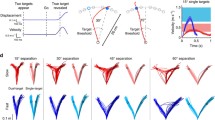Abstract
Several studies have shown that humans exhibit an intimate knowledge of prospective motor actions when imagining and planning movements. To probe this knowledge, we used a 2-alternative forced-choice task to determine whether people are consistent with Fitts’s law when choosing the movement they perceive to require the least movement time. We hypothesized that participants would choose the target with the lower index of difficulty with a probability greater than 0.5 in all situations. Participants performed almost perfectly when one of the targets was closer, wider, or both. Contrary to expectations, however, participants showed biases for close targets when one of the targets was closer and narrower. We argue that this pattern of behavior may result from a subjective representation of movement time that is based on both Fitts’s law and the distance to the target, suggesting a preference for movements that are less effortful.



Similar content being viewed by others
References
Augustyn JS, Rosenbaum DA (2005) Metacognitive control of action: preparation for aiming reflects knowledge of Fitts’s law. Psychon Bull Rev 12:911–916
Ayer M, Brunk HD, Ewing GM, Reid WT, Silverman E (1955) An empirical distribution function for sampling with incomplete information. Ann Math Stat 26:641–647
Cerritelli B, Maruff P, Wilson P, Currie J (2000) The effect of an external load on the force and timing components of mentally represented actions. Behav Brain Res 108:91–96
Davidson PR, Wolpert DM (2005) Widespread access to predictive models in the motor system: a short review. J Neural Eng 2:S313–S319
Decety J, Lindgren M (1991) Sensation of effort and duration of mentally executed actions. Scand J Psychol 32:97–104
Decety J, Jeannerod M (1995) Mentally simulated movements in virtual reality: does Fitts’s law hold in motor imagery? Behav Brain Res 72:127–134
Fitts PM (1954) The information capacity of the human motor system in controlling the amplitude of movement. J Exp Psychol 47:381–391
Fitts PM, Peterson JR (1964) Information capacity of discrete motor responses. J Exp Psychol 67:103–112
Gescheider GA (1997) Psychophysics: the fundamentals. Lawrence Erlbaum, Mahwah
Grosjean M, Shiffrar M, Knoblich G (2007) Fitts’s Law holds for action perception. Psychol Sci 18:95–99
Harris CM, Wolpert DM (1998) Signal-dependent noise determines motor planning. Nature 394:780–784
Jeannerod M (2001) Neural simulation of action: a unifying mechanism for motor cognition. Neuroimage 14:S103–S109
Kording KP, Fukunaga I, Howard IS, Ingram JN, Wolpert DM (2004) A neuroeconomics approach to inferring utility functions in sensorimotor control. PLoS Biol 2:e330
Mackenzie CL (1987) Three-dimensional movement trajectories in Fitts’ task: implications for control. Q J Exp Psychol 39A:629–647
Mackenzie IS, Buxton W (1992) Extending Fitts’ Law to two-dimensional tasks. In: Proceedings of the ACM conference on human factors in computing systems––CHI ’92, pp 219–226
Meyer DE, Abrams RA, Kornblum S, Wright CE, Smith JE (1988) Optimality in human motor performance: ideal control of rapid aimed movements. Psychol Rev 95:340–370
Miller J, Ulrich R (2001) On the analysis of psychometric functions: the Spearman–Karber method. Percept Psychophys 63:1399–1420
Pandy MG (2001) Computer modeling and simulation of human movement. Annu Rev Biomed Eng 3:245–273
Plamondon R, Alimi AM (1997) Speed/accuracy trade-offs in target-directed movements. Behav Brain Sci 20:279–303; discussion 303–349
Rosenbaum DA, Halloran ES, Cohen RG (2006) Grasping movement plans. Psychon Bull Rev 13:918–922
Schmidt RA, Lee TD (2005) Motor control and learning: a behavioral emphasis. Human Kinetics, Champaign
Sirigu A, Duhamel JR, Cohen L, Pillon B, Dubois B, Agid Y (1996) The mental representation of hand movements after parietal cortex damage. Science 273:1564–1568
Tanaka H, Krakauer JW, Qian N (2006) An optimization principle for determining movement duration. J Neurophysiol 95:3875–3886
Todorov E, Jordan MI (2002) Optimal feedback control as a theory of motor coordination. Nat Neurosci 5:1226–1235
Trommershauser J, Maloney LT, Landy MS (2003) Statistical decision theory and the selection of rapid, goal-directed movements. J Opt Soc Am A Opt Image Sci Vis 20:1419–1433
Trommershauser J, Gepshtein S, Maloney LT, Landy MS, Banks MS (2005) Optimal compensation for changes in task-relevant movement variability. J Neurosci 25:7169–7178
Trommershauser J, Landy MS, Maloney LT (2006) Humans rapidly estimate expected gain in movement planning. Psychol Sci 17:981–988
Tversky A, Kahneman D (1981) The framing of decisions and the psychology of choice. Science 211:453–458
van Beers RJ, Haggard P, Wolpert DM (2004) The role of execution noise in movement variability. J Neurophysiol 91:1050–1063
Wolpert DM, Ghahramani Z (2000) Computational principles of movement neuroscience. Nat Neurosci 3(Suppl):1212–1217
Acknowledgments
We would like to thank Konrad Kording, Jason Augustyn, Luc Tremblay, and students in the Prism Lab for constructive comments on the manuscript and study. We would also like to thank David Rosenbaum and an anonymous reviewer for comments that greatly improved the clarity of the manuscript. Scott Young was supported by a scholarship from the Natural Sciences and Engineering Research Council (NSERC) at the time that this research was performed.
Author information
Authors and Affiliations
Corresponding author
Rights and permissions
About this article
Cite this article
Young, S.J., Pratt, J. & Chau, T. Choosing the fastest movement: perceiving speed-accuracy tradeoffs. Exp Brain Res 185, 681–688 (2008). https://doi.org/10.1007/s00221-007-1192-9
Received:
Accepted:
Published:
Issue Date:
DOI: https://doi.org/10.1007/s00221-007-1192-9




